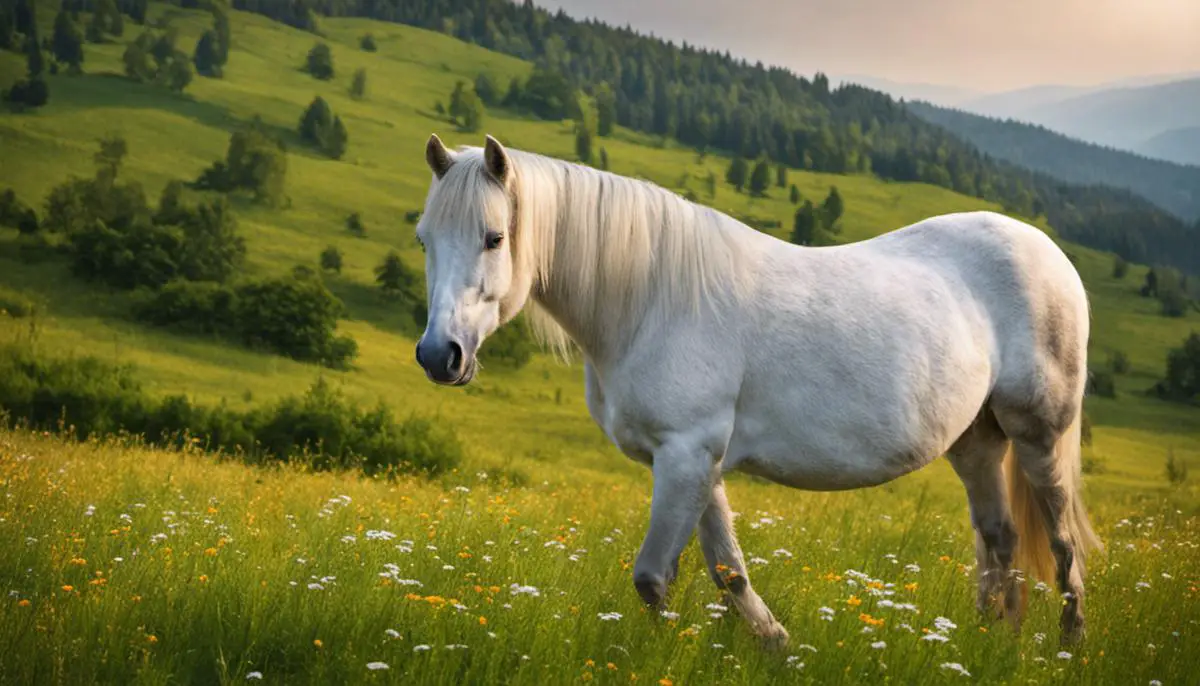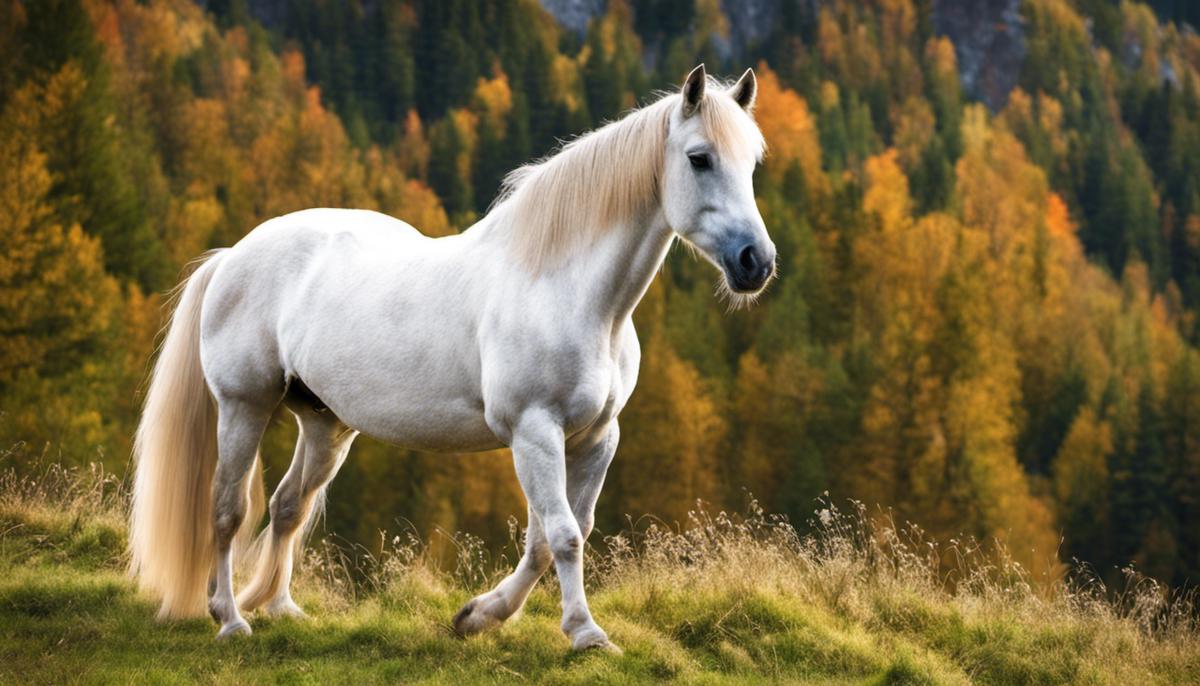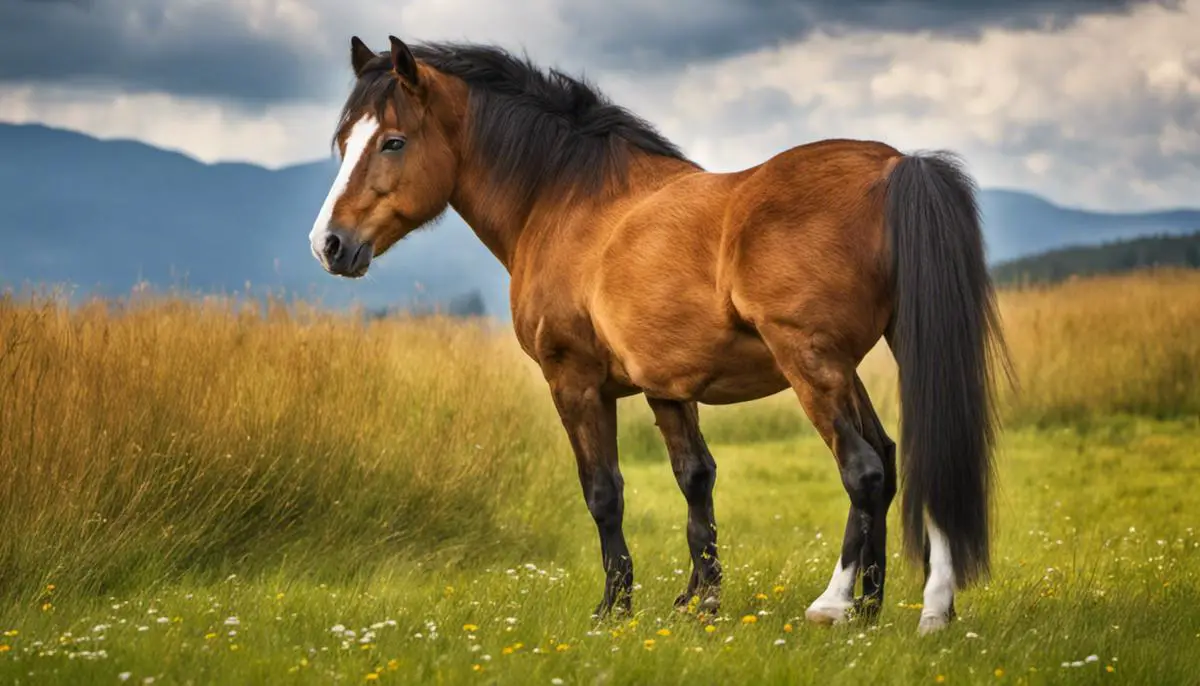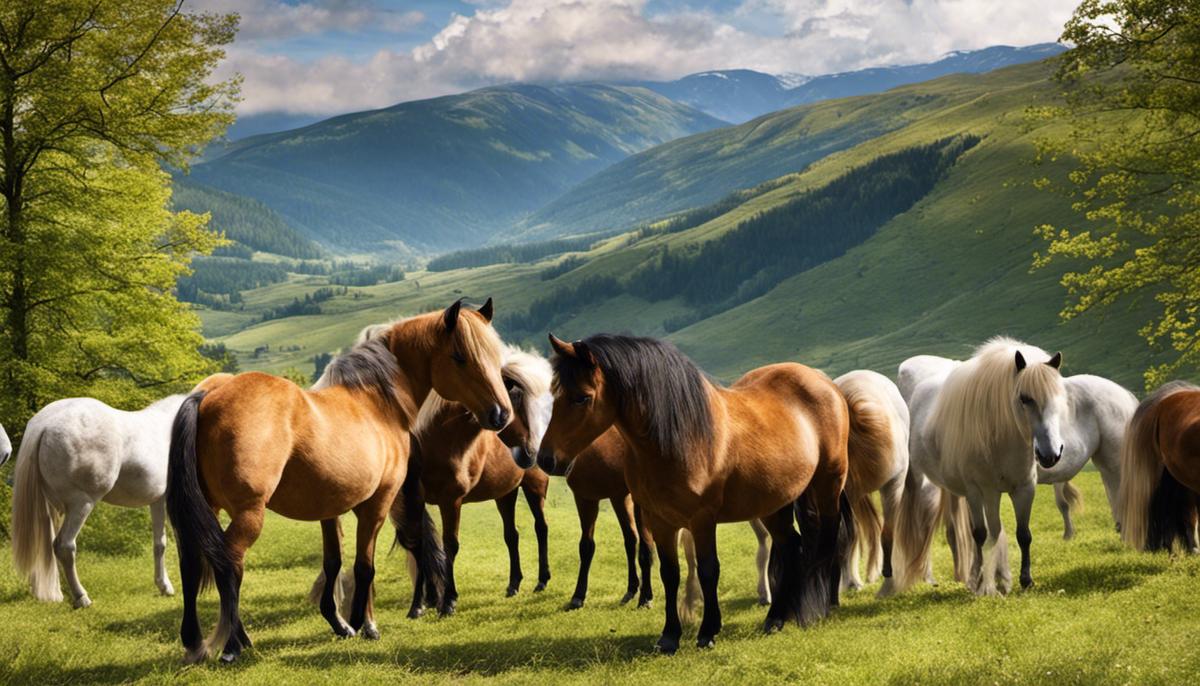Steeped in rich history and originating from the rugged terrains of the European mountains, the Carpathian pony bears a testament to resilience and grace. Having evolved through centuries, this breed commands a fascinating tale encompassing its origin, remarkable physical attributes, temperament, and its noted role in society. Diving deep into the ancestry of the Carpathian pony not only unravels the intriguing path of its development, but also fosters an appreciation for its compelling journey. As we explore their distinctive coloring and body structure, we reveal what makes this breed truly unique. Moreover, gaining insights into their general behavior and health conditions sheds light on their care needs, crucial for any potential owner. Lastly, understanding the Carpathian pony’s valuable contribution to society fosters a deeper connection to this resilient breed.
Table of Contents (Horspedia)
Origin and History of the Carpathian Pony
Origins and Ancestry of the Carpathian Pony
The Carpathian pony, also known as the Hucul pony, has deep roots that trace back to the Carpathian mountain region of Eastern Europe, stretching across modern day Romania, Hungary, Slovakia, Poland and Ukraine. While the precise date of origin is unknown, evidence suggests that the breed has been present in the region for thousands of years. Ancient remains and historic artifacts indicate that as far back as the Bronze Age, a primitive horse of similar type roamed the Carpathian forests, contributing to the ancestry of the present-day Carpathian pony.Historical Development and Significant Roles
Historically, the Carpathian pony played a significant role in the rural mountain economies due to its strength, endurance, and adaptability to harsh climates. They were primarily used for farming, forestry work, and transportation in rough terrains, serving as indispensable assets for farming communities. During World War I and World War II, these ponies were employed by the military, demonstrating their adaptability to a wide range of roles.Modern Carpathian Pony: Evolution over the Years
The modern Carpathian pony retains much of the physical characteristics and traits of its ancestors, reflecting its adaptation to the rigorous mountainous environment. It is compact yet sturdy, with a robust build, a hardy constitution, and an innate ability to survive in harsh conditions with minimal maintenance. Bred selectively over the years for its endurance, strength, and versatility, the Carpathian pony stands testament to the breed’s long and varied history.Prominent Features and Unique Characteristics
Among the unique characteristics that stand out in Carpathian ponies is their inherent toughness and tenacity. Their small stature, typically measuring between 12.1 to 13.3 hands high, belies their strength and stamina. Their tough hooves rarely require shoeing even in tough terrains. They are known for their docile temperament, high intelligence, and eagerness to work, making them ideal for a plethora of tasks including trekking, harness driving, and even therapeutic riding.Current Condition and Future Outlook
Currently, the Carpathian pony, or Hucul pony as it’s also referred to, is heralded as a significant aspect of local heritage, with multiple organizations dedicated to its protection. A variety of breeding initiatives throughout Europe work steadfastly to maintain the breed’s health and genetic diversity. Although the use of the Carpathian pony in laborious tasks has diminished, its popularity for riding, sports, and tourism, especially in its native region, remains undiminished.
Physical Characteristics of the Carpathian Pony
Distinctive Traits of the Carpathian Pony
Having a unique set of attributes, the Carpathian or Hucul pony differentiates itself from other horse breeds. The breed’s average height falls between 12.3 to 14.2 hands (approximately 50 to 58 inches) at the withers, the uppermost point on a horse’s back situated at the neck’s base. This measurement is a median size for pony breeds, especially those used for work or in mountainous environments, where the Carpathian pony finds its origin.
A distinguishing feature of this breed is its hearty and tough build, intended to withstand harsh climates and rugged mountain terrain. The Carpathian pony has a compact and muscular body, a broad, deep chest, and powerful, short legs, equipping them with impressive strength and stamina. Their hooves are notably sturdy and resistant, offering a firm grip on rocky paths in mountainous regions.
Colorations and Markings of the Carpathian Pony
Carpathian ponies offer a breadth of unique colorations that can serve as identifying features. The most common colors seen in this breed are bay, black, chestnut, and dun. Dun-colored Carpathian ponies usually exhibit a characteristic primitive marking known as the dorsal stripe, a darker line that runs down the center of their back. Roan colorations also manifest in this breed, though they are less common.
Each horse has a distinct coat pattern, often featuring lighter alternating with darker patches. Each horse’s coat coloring can provide clues for identification, as certain combinations and patterns are more prevalent among Carpathian ponies compared to other equine breeds.
An Introduction to the Carpathian Pony
The Carpathian Pony, known for its unique physical features and adaptability, distinctively stands apart from other breeds. This mountain pony, characterized by its medium height and robustly compact body structure, is easily recognizable. Its dense dark coat and resilient hooves further distinguish it from others.
In addition, specific features, such as the dorsal stripe seen in dun-colored ponies or unique color combinations that are specific to the Carpathian breed, can also aid in identification. Notably, these ponies are not just physically appealing, but they also possess a gentle nature. Their ability to adapt to harsh conditions makes them ideal companions in mountainous regions.

Behavior and Temperament of the Carpathian Pony
Understanding the Temperament and Behavior of the Carpathian Pony
This sturdy creature, also known as the Hucul pony, originates from the tough mountainscape of Eastern Europe. Impervious to harsh climates and challenging terrains, the Carpathian Pony is distinguished by its calm temperament.
Besides being hardy and adaptable, this breed is lauded for its exceptional gentleness. This trait makes them the preferred choice for beginner horse owners or families with young children. Despite being subjected to stressful environments or unfamiliar landscapes, the Carpathian Pony remains unflappable and friendly. This highlights their resilient nature, which is likely a result of their evolution in the rugged Carpathian Mountains.
Suitability for Different Owners
Given their calm demeanor and sturdy size, Carpathian ponies are suited for a variety of equestrian activities. They are especially favored for recreational horseback riding and competitive driving events. Their compact size and strength are advantageous in sports like trail riding and endurance events. While they can be ridden by adults, their small stature makes them particularly suitable for children or novice riders.
Despite their lovable nature, these ponies are not ideal for everyone. They are a robust breed that thrives on work and exercise, making it essential for potential owners to have the necessary time and energy to meet their needs. They are not best suited for people seeking a competitive show animal, as their abilities lie more in endurance and strength rather than speed and agility.
Ideal Environment for the Carpathian Pony
The Carpathian ponies are most comfortable in environments replicating their native habitat – mountainous regions with colder climates. They are well-adapted to survive in challenging terrains owing to their years of evolution in the Carpathian mountains. Their double-layered coat gives them exceptional protection against harsh weather conditions, making it unnecessary to stable them in the winter.
However, adapting to more controlled environments such as stables or pastures shouldn’t pose a significant problem due to their generally adaptable nature. What’s crucial is the availability of ample space to roam and exercise to ensure their physical well-being.
In Summary
Wrapping up, the Carpathian pony, due to its gentle personality and adaptable characteristics, has the potential to be a charming addition to various households. It’s crucial for any potential owners to comprehend the level of care, environment suitability, and long-term commitment these sturdy ponies necessitate for them to flourish.

Care and Health Conditions of the Carpathian Pony
Health Concerns of Carpathian Pony
Commonly known as the Hucul Pony, the Carpathian Pony is generally known for its robust health and resilience. Despite these attributes, they are not immune to some prevalent equine diseases. Conditions like laminitis, a hoof-related pain that could be a result of overfeeding or improper foot care, could affect these ponies. Additionally, they might be susceptible to Equine Metabolic Syndrome, a condition akin to type-2 diabetes in humans that could potentially lead to obesity and further lead to laminitis.
Respiratory ailments such as equine influenza and equine herpesvirus, although not breed-specific, can manifest and might become serious if not promptly tackled. Therefore, to mitigate these potential health conditions, it’s essential that Carpathian ponies receive regular veterinary inspections, proper vaccinations, and timely medical treatment when required.
Nutrition and Diet of Carpathian Ponies
Carpathian Ponies are known for their ability to thrive on sparse diet. However, to maintain optimal health, they should be provided with a balanced diet that includes foods rich in essential nutrients. Their diet should primarily consist of roughage, such as hay or pasture. Although they are excellent foragers, supplemental feeding may be necessary during the colder months when natural forage is scarce.
Grains and concentrates can also be added to their diet, but with caution. Overfeeding, especially with rich, calorie-dense feeds, can lead to obesity and associated health problems like laminitis. Plenty of fresh, clean water should always be available, as it is vital for the pony’s digestion and overall health.
Access to salt or a mineral block will also benefit the pony, providing necessary minerals not always found in sufficient quantities in hay or pasture.
Understanding the Care and Maintenance of Carpathian Ponies
To ensure a healthy and happy life for a Carpathian Pony, appropriate care and maintenance are vital. By nature, these ponies need ample access to open spaces where they can freely move around and exercise. Due to their adaptation to harsh environments, they are capable of living outdoors throughout the year, provided they have access to shelter during extreme weather conditions.
Grooming on a regular basis is critical for maintaining their skin health and can also act as a bonding time for the pony and its owner. Similarly, consistent hoof care, such as cleaning and trimming every six to eight weeks helps prevent various foot-related health issues including laminitis.
Being social by nature, it is ideal to house Carpathian Ponies alongside other horses. However, if that’s not possible, they can also mingle well with other farm animals.
Having an experienced equine vet for regular health check-ups, timely vaccinations, and immediate medical responses when necessary is key to the overall wellbeing of a Carpathian Pony.

The Carpathian Pony’s Role in Society
The Carpathian Pony’s Role in Society
The Carpathian pony, often referred to as the Hucul pony, holds an integral role in several societies, particularly in Eastern Europe where they originate. These versatile equines are primarily utilized as working animals in agriculture, transportation, and forestry. Their notable strength, endurance, and adeptness in challenging terrains make them ideal for such roles where motorized vehicles might be impractical.
Moreover, these ponies are frequently employed in harness and saddle for recreational and therapeutic riding. Their composed temperament, robust body structure and relatively small height —usually standing between 12.3 and 13.3 hands—makes them an excellent choice for inexperienced or younger riders.
It is also not uncommon to find Carpathian ponies in show careers. With their striking looks and remarkable agility, they often participate in horse shows and competitions, wowing audiences with their distinct coat colors that span from bay and chestnut to black and dun.
Carpathian Pony: A Companion Animal
Despite their working roles, Carpathian ponies also serve as beloved companion animals. They are known for their friendly disposition, sociability, and easy-to-train nature which fosters a strong bond with their handlers. Owning a Carpathian pony not only provides companionship but also contributes to healthy outdoor lifestyles and activities for families and individuals.
Preservation of the Carpathian Pony
Efforts to preserve and protect the Carpathian pony breed are underway, given their declining populations. These initiatives are largely led by breeding organizations and equine enthusiasts who understand the historical and societal value of these unique ponies. These groups focus on promoting the breed, establishing conservation breeding programs, and educating the public about the breed’s unique traits and roles.
There’s an increased emphasis on genetic preservation to maintain the breed’s unique traits, and to avoid dilution or loss due to crossbreeding. These preservation projects involve documentation of bloodlines, selective breeding, and isolation of purebred herds.
Environmental initiatives are also essential as habitat reduction due to urban expansion and farming pressures has significantly affected the breed’s population. Providing protected areas where these ponies can graze and reproduce is part of these initiatives.
Conclusion
In summary, the Carpathian pony serves multifaceted roles in society as a working animal, a show pony, and a companion animal. With ongoing efforts to preserve and protect the breed, the aim is to ensure that future generations can appreciate the versatility and unique qualities of the Carpathian pony.

The Carpathian pony, while small, holds an important place in our societal structures. Its versatile nature allows it to be a working animal, show pony, and companion animal alike, demonstrating its adaptability and unmatched value. The need for preservation efforts becomes clearer as we examine their critical role. Moreover, understanding the inherent health conditions and care requirements associated with this breed guides potential owners through the journey of providing a fulfilling life for these hardy animals. In essence, the story of the Carpathian pony is one of endurance, adaptability, and enchantment. It urges us to respect and appreciate the small yet significant members of our natural world, steering us towards the path of co-existence and mutual growth.

